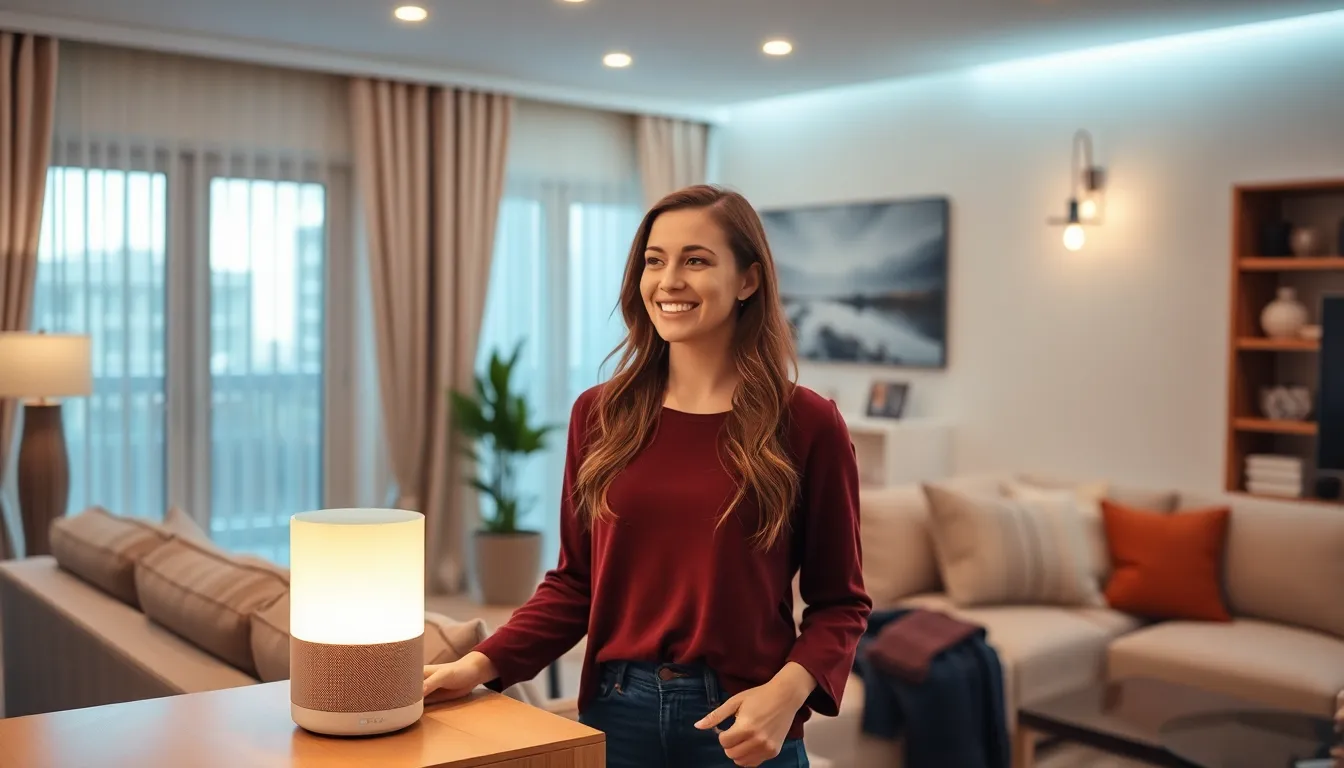Imagine walking into your home and commanding it to do your bidding—lights dim, music plays, and the coffee brews, all without lifting a finger. Welcome to the world of voice-controlled homes, where technology meets convenience in a delightful dance of modern living. It’s like having a personal assistant who never complains about overtime or forgets your coffee order!
In a time when multitasking is the norm, voice control offers a hands-free solution to everyday chores. Whether it’s turning up the thermostat or asking for the latest weather update, this smart technology transforms how we interact with our spaces. Get ready to explore how voice-controlled homes can simplify life, entertain guests, and maybe even impress that one friend who still thinks flipping switches is the height of sophistication.
Table of Contents
ToggleOverview of Voice-Controlled Homes
Voice-controlled homes utilize advanced technology to simplify daily tasks and enhance convenience. Users can control lighting, security systems, and temperature settings through simple voice commands. This hands-free interaction promotes efficiency, allowing for multitasking in various aspects of life.
Smart speakers serve as central hubs that connect to multiple devices. These speakers can integrate with smart bulbs, thermostats, and security cameras, creating an interconnected home ecosystem. Voice assistants such as Amazon’s Alexa, Google Assistant, and Apple’s Siri provide intuitive interfaces for navigating household functionalities.
Efforts in voice recognition technology contribute to improved accuracy and responsiveness. Homes equipped with this technology adapt to individual preferences and routines. Adjustments can occur automatically based on user behavior, adding an extra layer of convenience to everyday living.
Data from Statista indicates that the global smart home market is projected to reach approximately $320 billion by 2025. Such growth highlights the increasing popularity of voice-controlled systems. Voice technology not only streamlines home management but also enhances security with features like remote monitoring and automated alerts.
Integration of voice control extends beyond typical household functions. It offers entertainment options such as playing music or streaming video with simple requests. Families can engage in interactive experiences, using voice commands to access games or trivia activities.
Voice-controlled homes represent the future of residential living. With continued advancements, users can expect even greater innovations that increase functionality and improve user experience. Enhanced communication between devices creates a seamless living environment that suits modern lifestyles.
Key Features of Voice-Controlled Homes

Voice-controlled homes incorporate several advanced features that greatly enhance user experience.
Smart Assistants
Smart assistants play a crucial role in voice-controlled homes. Devices like Amazon Alexa, Google Assistant, and Apple Siri serve as centralized hubs for managing various tasks. They respond to voice commands, allowing users to control multiple functions hands-free. These assistants learn from user interactions, improving accuracy and personalization over time. Routine tasks, such as setting reminders or checking the weather, become effortless. Users enjoy the convenience of managing essential functions simply by speaking.
Connectivity with Smart Devices
Connectivity with smart devices stands out as a key feature. Voice-controlled systems integrate seamlessly with various devices, including smart bulbs, thermostats, and security cameras. Homeowners benefit from the ability to control these devices through simple voice commands. For instance, one can dim the lights or adjust the thermostat without needing to physically interact with each gadget. Furthermore, this interoperability allows users to create automated routines, enhancing home management efficiency. The result is a cohesive, smarter living environment that aligns with modern lifestyles.
Benefits of Voice-Controlled Homes
Voice-controlled homes provide numerous advantages that significantly enhance daily living. These systems streamline tasks and promote an efficient, modern lifestyle.
Convenience and Accessibility
Convenience stands out as a primary benefit. Individuals can control devices simply through voice commands, eliminating the need for physical interaction. Adjusting lighting or thermostats becomes a seamless experience. Accessibility also improves for individuals with mobility challenges, allowing them to manage their environment effortlessly. Voice-activated systems support multi-tasking, enabling users to issue commands while engaged in other activities. Smart assistants learn user preferences over time, leading to customized responses and actions. The ability to set reminders or check information hands-free fosters independence for all users.
Energy Efficiency
Energy efficiency ranks as another key benefit of voice-controlled homes. Smart technology allows real-time adjustments to heating and cooling systems based on user activity and preferences. Homeowners can reduce energy consumption by programming devices to operate only when needed. For example, setting lights to turn off automatically when no one is present contributes to energy savings. Voice control also simplifies monitoring energy usage, empowering users to make informed decisions. Moreover, integrations with smart meters enhance awareness of energy consumption patterns. Overall, these systems promote sustainable living while reducing energy costs.
Challenges and Considerations
Voice-controlled homes introduce unique challenges alongside their advantages. Privacy and security issues arise with the data collected by voice assistants. Users may unknowingly share sensitive information during interactions. Hackers can target these systems to gain unauthorized access, increasing concerns about personal security. Companies implement encryption and data protection measures, yet users must remain vigilant. Regular updates and strong passwords help mitigate risks and maintain privacy.
Compatibility with existing systems also presents a challenge. Not all smart devices work seamlessly with voice assistants. Users encounter limitations when integrating legacy systems into a modern smart home ecosystem. Some manufacturers design devices that support specific platforms, leading to fragmentation. Researching compatibility before purchasing new devices ensures a smoother integration experience. Choosing products that support popular ecosystems enhances functionality and user satisfaction.
Future Trends in Voice-Controlled Homes
Voice-controlled homes will witness significant advancements in artificial intelligence. AI developments enhance voice recognition capabilities, allowing systems to understand context and nuance better. Increased personalization becomes possible as smart devices learn individual user preferences over time.
Integration with Internet of Things devices continues to expand. This creates seamless communication between various home systems. Users enjoy more comprehensive control over their environments through interconnected voice-activated devices, enhancing convenience and functionality.
Evolving privacy features also become a priority. Advanced encryption methods will protect user data more effectively. Companies will implement strict privacy controls to gain consumer trust, addressing concerns about data security and unauthorized access.
Automation will evolve alongside voice technology. Homeowners will set up more complex routines, automating multiple tasks with a single command. This increased efficiency simplifies daily routines and contributes to a seamless living experience.
Voice-controlled systems are set to integrate with augmented reality applications. This technological fusion allows users to issue commands while interacting with holographic interfaces, merging virtual experiences with real-world environments. Users will enjoy an immersive experience that enhances home management and entertainment.
Sustainability becomes a central theme. Voice-controlled devices will optimize energy usage, providing real-time feedback. Homeowners will effortlessly adjust systems for energy efficiency, reducing their carbon footprint and promoting sustainability.
Predictive analytics will revolutionize operations. Smart homes will anticipate user needs, adjusting settings proactively based on behavior patterns. This anticipatory approach enhances comfort while further simplifying home management.
Voice-controlled homes represent the future of residential living. Each advancement brings increased functionality, boosted user experience, and a harmonious blend of technology and home life.
Voice-controlled homes are transforming the way people live by offering unmatched convenience and efficiency. As technology continues to evolve users can expect even greater personalization and integration with their daily routines. The benefits extend beyond mere convenience; they enhance security and promote sustainable living through smart energy management.
While challenges such as privacy and compatibility remain, ongoing advancements in artificial intelligence and IoT integration promise to address these concerns. The future of home management is bright with voice technology leading the way. Embracing this innovation not only simplifies tasks but also enriches the overall living experience.






